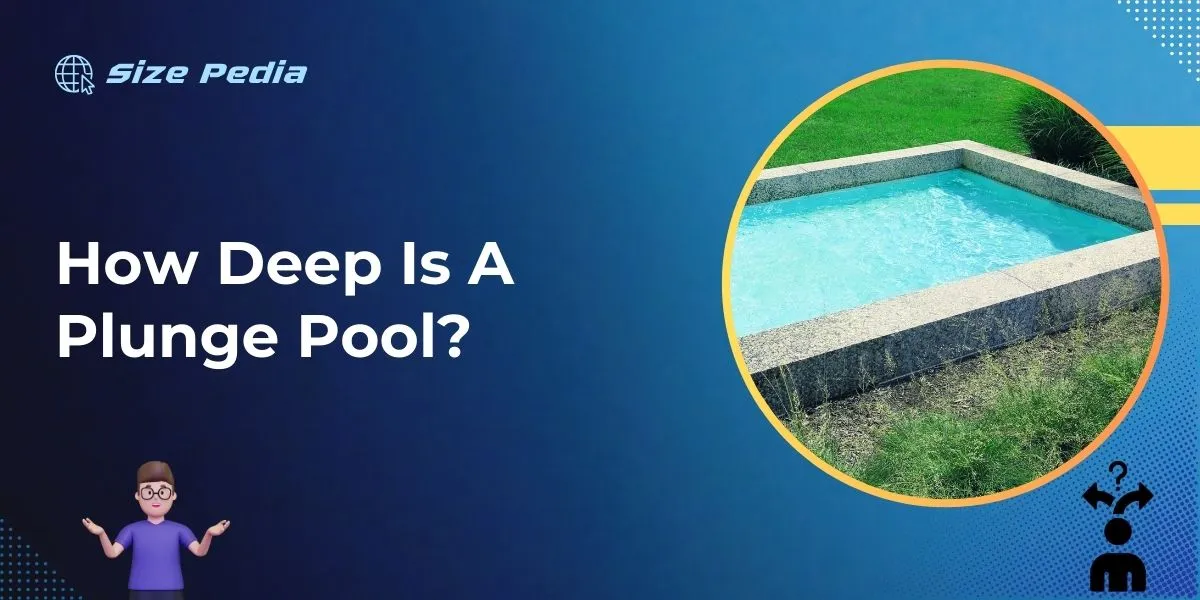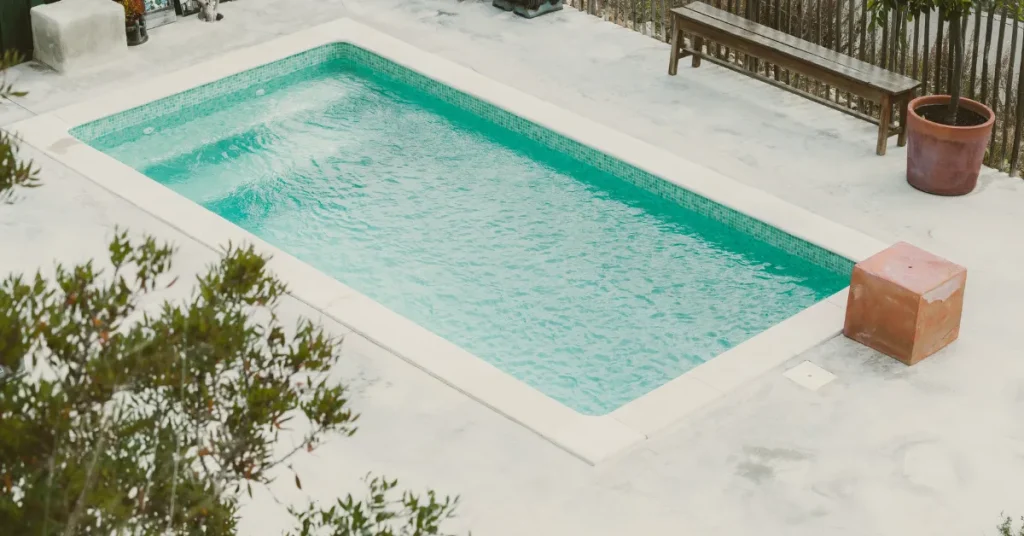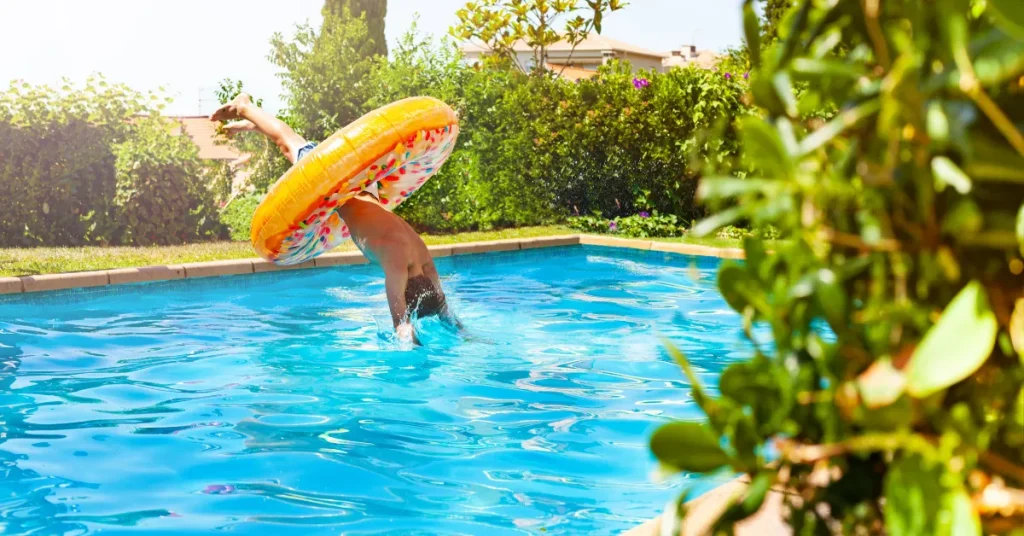A plunge pool typically ranges from 4 to 7 feet deep. These compact pools are designed for relaxation, not for swimming.
Plunge pools have become an increasingly popular feature in modern backyards and spa retreats. Their compact size makes them ideal for smaller spaces, while their depth is perfect for those looking to cool off or engage in low-impact water exercises.
Unlike larger swimming pools, a plunge pool focuses on depth rather than length or width, allowing for a full-body submersion in a confined area. This space-saving solution offers urban dwellers and those with limited outdoor space the luxury of a private water retreat.
People seeking the therapeutic benefits of water without the need for extensive swimming space often opt for these pools, making them a versatile and convenient option for relaxation and relief from the heat.

The Allure Of Plunge Pools
Imagine a compact oasis, a refreshing escape in your very own backyard – that’s the charm of plunge pools. These pint-sized pools pack a punch, providing an exquisite spot to cool off, unwind, or re-energize.
They occupy less space, making them perfect for smaller plots while delivering the quintessential pool experience. Embark on a journey to discover the enticing world of plunge pools.
Captivating Features
Dive into the world of plunge pools and their mesmerizing features. Unlike traditional pools, which demand extensive space and care, plunge pools cater to those seeking luxury in a limited area. Imagine:
- Perfect Dimensions: Sizing up to a cozy depth, these pools are tailored for ease and intimacy.
- Elegant Design: Each plunge pool boasts sleek contours and chic finishes.
- Custom Options: From vibrant tiles to soothing jets, customization breathes life into your aquatic haven.
- Eco-Friendly: Smaller volume means less water and energy, making plunge pools a sustainable choice.
Benefits In Compact Spaces
Plunge pools excel in smaller landscapes. Here’s why they’re the go-to for space-savvy pool lovers:
- Space Efficiency: They fit where traditional pools can’t, making them ideal for urban homes.
- Lower Cost: Smaller dimensions translate to more affordable installation and maintenance.
- Versatility: Whether it’s a rooftop or courtyard, plunge pools adapt to nearly any setting.
- Quality Over Quantity: Despite their size, these pools deliver a high-quality experience.
| Feature | Description |
| Depth | Typically 4 to 6 feet, perfect for relaxing dips |
| Shape | Custom shapes from square to circular adapt to space |
| Size | Generally 6 to 14 feet, crafted for snug spaces |
| Cost | More economical due to reduced materials and labor |
Unlock the potential of your limited outdoor area with a plunge pool. Savor a touch of indulgence without demanding too much space, effort, or expenses.
Plunge pools offer that priceless blend of functionality and beauty, representing the epitome of elegance and smart design in compact living spaces.
Measuring The Depth Of Plunge Pools

When considering a plunge pool, depth is a key factor. Plunge pools vary in depth, catering to different preferences and uses. Let’s dive into what makes a plunge pool not just a pool but a perfect personalized oasis.
Average Depths Explored
Plunge pools are known for their compact luxury. They usually range from 4 to 7 feet deep. This depth allows for a refreshing dip while keeping the pool size manageable.
| Size | Depth |
| Small | 4 feet |
| Medium | 5-6 feet |
| Large | 7 feet |
Factors Influencing Depth
Diverse factors determine the perfect depth for a plunge pool. These include:
- Space availability – Smaller spaces might require shallower pools.
- User safety – Depths that ensure the safety of all swimmers are crucial.
- Intended use – Leisure versus exercise can influence the ideal depth.
- Installation location – Ground conditions may limit depth options.
- Building codes – Local regulations can impact depth.
Selecting the depth for a plunge pool must balance desire with practicality. Each factor must be weighed to ensure the pool is a delight.
Depth decisions make a plunge pool unique. Understanding the variables involved will guide the choice, providing a customized pool experience to enjoy.
Plunge Pool Design Variations
Exploring the Depths and Designs of Plunge Pools
Plunge pools are the gems of compact luxury, fitting even in smaller backyards. These pools prioritize depth rather than length or width.
Styles and depths vary widely, offering a cool escape or a fitness spot. This section dives into the different designs of plunge pools and how depth enhances the overall experience.
Common Designs
Dive into the world of plunge pools with these popular styles:
- Rectangular: A classic shape that suits most spaces.
- Round: Great for a central feature in gardens.
- Naturalistic: Mimics natural bodies of water.
- Infinity edge: The water seems to vanish into the horizon.
- Corner: Fits snugly into corner spaces.
These shapes often come in standard depths, usually around 4 to 5 feet. Perfect for a refreshing dip or a robust aqua workout.
Innovations In Plunge Pool Depths
Advancements in design cater to diverse needs:
- Adjustable floors: Modify the depth with the touch of a button.
- Hybrid pools: Feature zones with varied depths in one pool.
- Compact deep-dives: A small footprint with depths reaching up to 7 feet.
Whether shallow to lounge or deep for exercise, these plunge pools can morph to meet the moment.
Safety Considerations In Depth Planning
Choosing the correct depth for a plunge pool is crucial. It impacts both enjoyment and safety. A balance between practicality and precaution is essential. Knowing the best depth requires understanding risks and safety measures.
Depth Related Risks
Diving dangers arise in shallow pools. Head and neck injuries can occur. Accidental slips are also a concern. In deeper pools, swimmers may struggle to reach the surface. Always consider depth against user safety.
Safety Measures
- No diving signs reduce injury risks.
- Depth markers keep swimmers informed.
- Ensure adequate supervision at all times.
- Lifesaving equipment should be accessible.
- Plan for emergency scenarios.
Maintenance And Depth Management
Taking care of a plunge pool means paying attention to how deep it is. A well-maintained depth keeps the pool safe and enjoyable. Let’s dive into the details.
Upkeep Challenges
Keeping your plunge pool in top shape comes with unique challenges:
- Regular cleaning prevents algae and ensures water clarity.
- Water levels must stay consistent for structural balance.
- Seasonal changes can affect water depth and quality.
Longevity And Depth
Maintaining depth is key to your plunge pool’s long life:
- Check depth often. It shows if the pool is losing water.
- Fix leaks quickly. Leaks can change depth and damage the pool.
- Controlled depth helps keep the pool structure sound over time.
Real-world Examples Of Remarkable Depths

Plunge pools, tranquil and serene, differ greatly in depth. From compact backyard retreats to vast natural wonders, depths transform these water bodies into unique experiences. Let’s dive into real-world examples to grasp the depth and allure of various plunge pools.
Notable Plunge Pools
Plunge pools come in diverse shapes and sizes. Some stretch deep into the earth, while others remain shallow. Renowned pools worldwide display the versatility of these watery havens.
- Ik Kil, Mexico: A natural pit, with vines cascading over its sides. The water lies about 26 meters (85 feet) below ground level.
- Devil’s Pool, Zambia: On the edge of Victoria Falls. Swimmers can peek over the world’s largest waterfall with depths reaching 2 meters (6.5 feet).
- Homestead Crater, Utah: A geothermal spring inside a limestone rock, boasting depths of up to 14 meters (45 feet).
Extreme Cases
Among plunge pools, some defy expectations with breathtaking depths. These extreme cases are rarities in nature and man-made marvels alike.
| Plunge Pool | Location | Depth |
| Nemo 33 | Belgium | 33 meters (108 feet) |
| Y-40 Deep Joy | Italy | 40 meters (131 feet) |
| Dean’s Blue Hole | Bahamas | 202 meters (663 feet) |
Nemo 33 was once the deepest in the world, created for divers. Y-40 Deep Joy now takes the title with warm, mineral-rich waters. Dean’s Blue Hole plunges into darkness, fascinating and intimidating for even seasoned divers.
FAQs About How Deep Is A Plunge Pool
What Is The Standard Depth Of A Plunge Pool?
Plunge pools typically have a standard depth ranging from 4 to 7 feet. This allows for sufficient immersion without the need for extensive swimming space. It’s an ideal depth for cooling off and enjoying water-based relaxation.
How Deep Are Plunge Pools Compared To Regular Pools?
Unlike regular swimming pools, which can be over 8 feet deep, plunge pools usually max out at about 7 feet. This keeps them compact and manageable for smaller spaces. They’re designed for lounging and dipping rather than swimming laps.
Can Plunge Pools Be Customized In Depth?
Yes, plunge pools are customizable in depth. Homeowners can work with contractors to define their preferred depth. Factors like personal use, backyard size, and safety will influence the final depth decision.
Do Plunge Pools Require Less Maintenance Than Larger Pools?
Plunge pools require less maintenance due to their smaller size, which means less water, chemicals, and cleaning time. This makes plunge pools an efficient choice for those seeking lower upkeep costs.
Conclusion
Diving into the depths of a plunge pool offers a refreshing escape. Typically, these pools span from 4 to 10 feet deep. They cater to leisurely dips and invigorating jumps alike. Remember, depth may vary based on design and purpose.
Before taking the plunge, always check the specifications for a safe and enjoyable experience.
Resources:
1. https://directives.sc.egov.usda.gov/17522.wba
